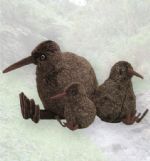
|
Kiwi (spotted)
Kiwis are endemic to New Zealand and renown for several unique features. They have no wings or tail, they have nostrils at the end of their beak, and they lay the largest eggs of all birds in proportion to their body size.
|
|
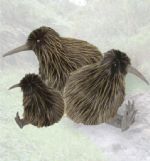
|
Kiwi (plush)
Kiwis are endemic to New Zealand and renown for several unique features. They have no wings or tail, they have nostrils at the end of their beak, and they lay the largest eggs of all birds in proportion to their body size.
|
|
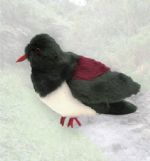
|
Kereru
The Kereru or NZ Pigeon is found in native lowland forests, city parks and some urban gardens. They play an important ecological role in dispersing seeds for native forest regeneration. Small Pigeon is 23cm.
|
|
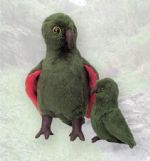
|
Kea
The Kea is the worlds only alpine parrot. Keas are renown for their inquisitive nature and comic antics. Their name derives from their call "Keaaa", delivered mainly in flight.
Small Kea is 15 cm.
Medium Kea is 34cm.
|
|
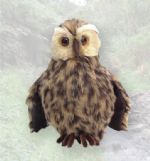
|
Morepork
The Morepork (or Ruru, NZ Owl) is found throughout New Zealand. Its characteristic call of "more-pork" can be heard in suburban gardens, reserves and native forests. A nocternal bird, it is commonly seen at dusk. Small Morepork is 19cm
|
|
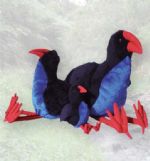
|
Pukeko
The Pukeko is essentially a bird of the lowland swamps, but has become widespread throughout New Zealand with the development of farming. It is commonly seen foraging on urban and rural grasslands.
Small Pukeko is 15cm
Medium Pukeko is 34cm
|
|
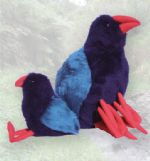
|
Takahe
The Takahe is one of the worlds most endangered birds. Formerly widespread throughout New Zealand it was thought to be extinct by 1900. In 1948 however, a small population was re-discovered in the Murchison Mountains in the South Island.
Small Takahe is 16cm
Medium Takahe is 35cm
|
|
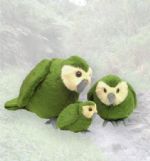
|
Kakapo
The Kakapo is the worlds rarest, heaviest and only flightless parrot. The Maori name Kakapo, means night parrot. Whilst it lives mainly on the ground Kakapo's can climb trees.
Small Kakapo is 19cm.
Medium Kakapo is 35cm.
Large Kakapo
|
|
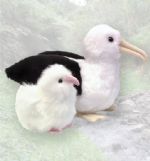
|
Royal Albatross
The Royal Albatross is one of the largest flying birds (wingspan over 3 meters) It spends most of its life gliding above the southern oceans.
Chick toy is 13cm.
Medium toy is 31cm.
|
|
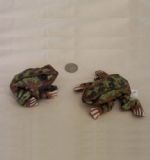
|
Archey's Frog
A critically endangered endemic frog about 4 cm long, restricted to the Coromandel Peninsula and parts of Waikato. They inhabit wet places under rocks and rotting tree trunks and feed on small insects and grubs at night. These frogs are unusual in not having webbed feet and the adult stage develops in the egg (i.e. no free swimming tadpole.) They produce barely audible squeaks. CLICK HERE TO GO TO THE FROG SITE AND LEARN MORE ABOUT OUR FROGSwww.nzfrogs.org/
|
|
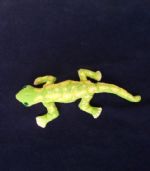
|
Gecko
New Zealand Geckos are unique in that they carry their eggs inside their bodies and the young are born alive.Green geckos are omnivorous and active by day usually inhabiting forest or scrub.Naultinus species can be uniformly green,lime or yellow;or variously patterned with spots or stripes.Most species are vocal,communicating by chirps,chatters,clicks and squeaks.Each species occurs in localized areas throughout NZ.
|
|
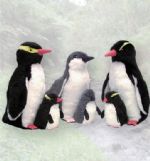
|
Penguins
Found only in New Zealand waters, the Hoiho, or Yellow-eyed Penguin is probably the worlds rarest penguin. A sedentary species, it seldom swims far from its breeding ground.
Blue Penguins (or Korora), are the smallest of all penguins, with 5 of the subspecies endemic to New Zealand. They are our most familiar penguin and are commonly seen around rocky coastlines.
Small Penguin is 11cm
Medium Penguin is 29cm.
|
|
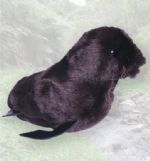
|
New Zealand Fur Seal
The new zealand fur seals are found around the coast of the south island and stewart Island.they can also be found in the north Island and south of Australia,and on the sub Antartic Islands. NZ Fur Seals have two very thick dark brown coats.Their diet consists of fish,squid and octopus.Exploitation by humans of the NZ Fur Seals has ended and this beautiful mammal is now fully protected,hopefully for all time.
|
|
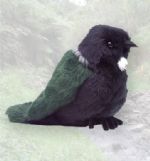
|
TUI
The tui,found only in New Zealand, is reknown for its variable, melodious songs. Relatively common in native forests,this honeyeater also lives in bush reserves and suburban gardens.Nectar is the most common food source,but tui also feed on fruits and small insects.Their flight is rapid,noisy,swooping and undulating and these aerial acrobatics easily identify the tui as does the tuft of white feathers at its throat.
|
|
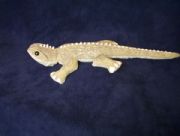
|
TUATARA
Tuatara are neither lizard or dinosaur-just an ancient New Zealander.They originated at the same time as dinosaurs.They belong to an ancient reptile group and are the only member to survive. Tuatara is Maori for spiny back,a feature that is easily seen.There are two recognised species,the common Tuatara and Brothers island Tuatara. Today tuatara are found only on small islands and mainland island sancutuaries.Tuatara can live to be 100 years or more.
|
|
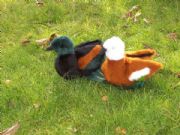
|
PARADISE SHELDUCK (We now have a male )
Paradise Shelduck are the largest duck in New Zealand. The male has a black head and dark body,while the female has a white head and orange brown body.Distributed throughout New Zealand they are often seen in pairs on farmland and other open areas especially around ponds and lakes.The alarm call of the male is a deep "ZONK-ZONK" while the female call is a shrill "zeek-zeek".
|
|
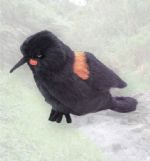
|
SADDLEBACK--TIEKE
The saddleback,found only in New Zealand,is one of three wattlebird species that include the kokako and extinct huia.It inhabits forest and thick scrub.often nesting and roosting near the ground where it is vulnerable to predators.Once widespread through New Zealand,all populations are now confined to the islands.
|
|
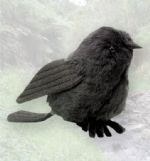
|
BLACK ROBIN
The black robin,endemic to the Chatham islands east of Christchurch,is one of the worlds rarest birds.It was saved from extinction by intensive conservation management and cross-fostering programmes with two closely related species.And are established on Mangere and South East islands in the Chatham group.
|
|
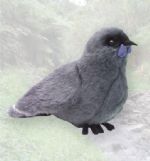
|
KOKAKO
The Kokako is an endangered wattlebird unique to New Zealand.Also in the same family are the saddleback and now extinct huia.The South Island Kokako (orange wattles)is thought to be extinct.The north island subspecies (blue wattles)is scattered on the mainland and offshore islands.It inhabits thick forest,preferring to run and hop through the canopy because of weak flight.It is reknown for its melodious and haunting song.
|
|
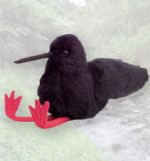
|
BLACK STILT
The black stilt,found only in New Zealand,is the worlds rarest wading bird.Once widespread throughout New Zealand,changes to their environment and predation has resulted in the stilts becoming an endangered species.They are now restricted to South Canterburys Mackenzie Basin.The department of conservation has an intensive management programme to prevent further decline in numbers.
|
|
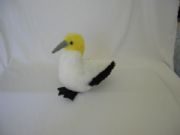
|
AUSTRALASIAN GANNET
Adult birds are common around New Zealand coastal waters with breeding colonies on many small islands and some headlands-notably Cape Kidnappers,Muriwai,and Farewell Spilt.On leaving the nest,most immature gannets migrate across the Tasman,spending two or three years around Australias eastern and southern coastline before returning to New Zealand.
|
|
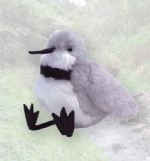
|
WRYBILL
The wrybill,endemic to New Zealand,is the only bird in the world to have a beak that curves side-ways.This right-curving bill is used to probe under stones or to sweep the surface of estuarine mud.Wrybill breed on shingle river beds in the South island.During the winter they migrate to harbours and estuaries mainly in the North island.About half the population winters in the Firth of Thames.
|
|
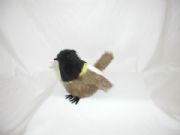
|
STITCHBIRD
By 1885,this endemic forest dweller had vanished from the North Island and all offshore islands except Little Barrier Island due to predation and habitat loss.Since 1980,they have been transferred to Tiritiri Matangi Is,Kapiti Is,Mt Bruce Wildlife Centre And Karori Wildlife Sanctuary,with a total population around 3,000(2005).Stitchbirds feed on nectar,small fruits and insects and nest in tree holes.
|
|



